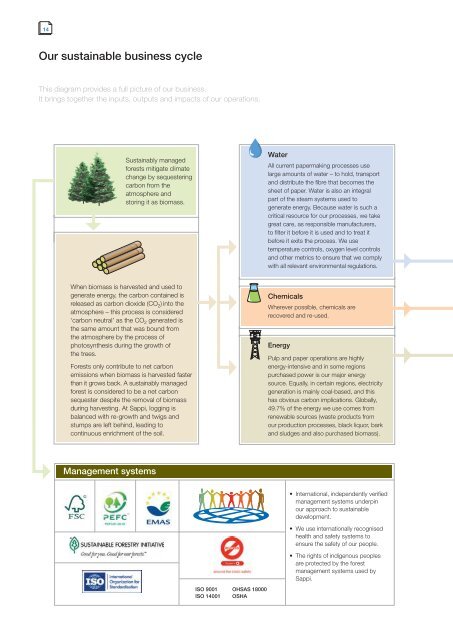Our performance in 2009 - Sappi
Our performance in 2009 - Sappi
Our performance in 2009 - Sappi
You also want an ePaper? Increase the reach of your titles
YUMPU automatically turns print PDFs into web optimized ePapers that Google loves.
14<br />
<strong>Our</strong> susta<strong>in</strong>able bus<strong>in</strong>ess cycle<br />
This diagram provides a full picture of our bus<strong>in</strong>ess.<br />
It br<strong>in</strong>gs together the <strong>in</strong>puts, outputs and impacts of our operations.<br />
Management systems<br />
Susta<strong>in</strong>ably managed<br />
forests mitigate climate<br />
change by sequester<strong>in</strong>g<br />
carbon from the<br />
atmosphere and<br />
stor<strong>in</strong>g it as biomass.<br />
When biomass is harvested and used to<br />
generate energy, the carbon conta<strong>in</strong>ed is<br />
released as carbon dioxide (CO 2) <strong>in</strong>to the<br />
atmosphere – this process is considered<br />
‘carbon neutral’ as the CO 2 generated is<br />
the same amount that was bound from<br />
the atmosphere by the process of<br />
photosynthesis dur<strong>in</strong>g the growth of<br />
the trees.<br />
Forests only contribute to net carbon<br />
emissions when biomass is harvested faster<br />
than it grows back. A susta<strong>in</strong>ably managed<br />
forest is considered to be a net carbon<br />
sequester despite the removal of biomass<br />
dur<strong>in</strong>g harvest<strong>in</strong>g. At <strong>Sappi</strong>, logg<strong>in</strong>g is<br />
balanced with re-growth and twigs and<br />
stumps are left beh<strong>in</strong>d, lead<strong>in</strong>g to<br />
cont<strong>in</strong>uous enrichment of the soil.<br />
ISO 9001 OHSAS 18000<br />
ISO 14001 OSHA<br />
Water<br />
All current papermak<strong>in</strong>g processes use<br />
large amounts of water – to hold, transport<br />
and distribute the fibre that becomes the<br />
sheet of paper. Water is also an <strong>in</strong>tegral<br />
part of the steam systems used to<br />
generate energy. Because water is such a<br />
critical resource for our processes, we take<br />
great care, as responsible manufacturers,<br />
to filter it before it is used and to treat it<br />
before it exits the process. We use<br />
temperature controls, oxygen level controls<br />
and other metrics to ensure that we comply<br />
with all relevant environmental regulations.<br />
Chemicals<br />
Wherever possible, chemicals are<br />
recovered and re-used.<br />
Energy<br />
Pulp and paper operations are highly<br />
energy-<strong>in</strong>tensive and <strong>in</strong> some regions<br />
purchased power is our major energy<br />
source. Equally, <strong>in</strong> certa<strong>in</strong> regions, electricity<br />
generation is ma<strong>in</strong>ly coal-based, and this<br />
has obvious carbon implications. Globally,<br />
49.7% of the energy we use comes from<br />
renewable sources (waste products from<br />
our production processes, black liquor, bark<br />
and sludges and also purchased biomass).<br />
International, <strong>in</strong>dependently verified<br />
management systems underp<strong>in</strong><br />
our approach to susta<strong>in</strong>able<br />
development.<br />
We use <strong>in</strong>ternationally recognised<br />
health and safety systems to<br />
ensure the safety of our people.<br />
The rights of <strong>in</strong>digenous peoples<br />
are protected by the forest<br />
management systems used by<br />
<strong>Sappi</strong>.
















